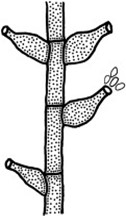Meliolaceae W. Martin, Mycol. Pap. 15: 23(1946)
Index Fungorum number: IF 80993; MycoBank number: MB 80993; Facesoffungi number: FoF 00741; 2371 species.
Colonies epiphyllous or hypophyllous. Hyphae superficial, brown, straight to flexuous, septate, branched, reticulate, with hyphopodia and phialides. Hyphopodia alternate to unilateral or opposite, 2-celled, brown. Setae straight to hooked, dark brown, forming on hyphae or ascomata. Sexual morph: Ascomata superficial, globose to subglobose, or flattened. Peridium comprising hyaline inner stratum, and dark brown outer stratum of textura angularis. Paraphyses evanescent. Asci 2–4-spored, unitunicate, asci wall attenuated or broken when mature, without a fixed shape. Ascospores ellipsoidal to oblong, 3–4-septate, constricted at the septum, hyaline when young, becoming brown when mature. Asexual morph: Phialides ampulliform or flask-shaped on hyphae. Conidiogenous cells formed directly from vegetative hyphae. Conidia unicellular, small and hyaline (adapted from Cannon & Kirk 2007).
Type genus – Meliola Fr.
Notes – Meliolaceae was established by Martin (1941) without a Latin diagnosis and later validated by Hansford (1946). Roger (1953) placed the Meliolaceae with nine other families in Hypocreales. This family has also been placed in Dothideales, Erysiphales, Meliolales, Myriangiales and Hypocreales at various times (Martin 1941, Luttrell 1951, 1989, Roger 1953, Ainsworth et al. 1971, Müller & von Arx 1973, Yarwood 1973, Barr 1976a, Eriksson 1981, Hawksworth et al. 1983). Ainsworth et al. (1971) and Eriksson & Hawksworth (1993) listed 50 genera in the family; later studies listed 25 genera (Hawksworth et al. 1995), 22 genera (Kirk et al. 2008), and 26 genera (Lumbsch & Huhndorf 2010) and seven genera (Hongsanan et al. 2015). A checklist provided by Zeng et al. (2017) included the number of species in each genus of Meliolaceae that are accepted in Index Fungorum and excluded some erroneous records. Species with valid information were accepted, and records with only a name available were noted in that study. Previous identifications of Meliolaceae were mainly based on host association and morphology. A formula proposed by Beeli (1920) was applied and modified for rapid identification among thousands of species in Meliolaceae. It used a numerical code to summarize key diagnostic characters, such as ascospores, ascomata, setae and appressoria. Mueller et al. (1991) stated that the basal cytoplasm in phialides has a conidiogenous function, and conidia-like spores were observed being extruded from terminal openings of phialides. The reason for the lack of studies on phialides is that they function only in some species, certain stages, or specific environmental conditions (Mueller et al. 1991). Therefore, phialides are considered the asexual morph of Meliolaceae. Although members of Meliolaceae are unculturable, sequence data can be obtained as described in Zeng et al. (2018). There are only 20 confirmed species of Meliolaceae with sequence data in GenBank, and it has not been determined if the species are host-specific. In the future, analysis of sequence data can replace the Beeli formula as a more reliable method to identify such groups, as well as establish host-specificity and the asexual morphs of Meliolaceae.

Figure 161 – Drawing of asexual morph of Meliolaceae.
